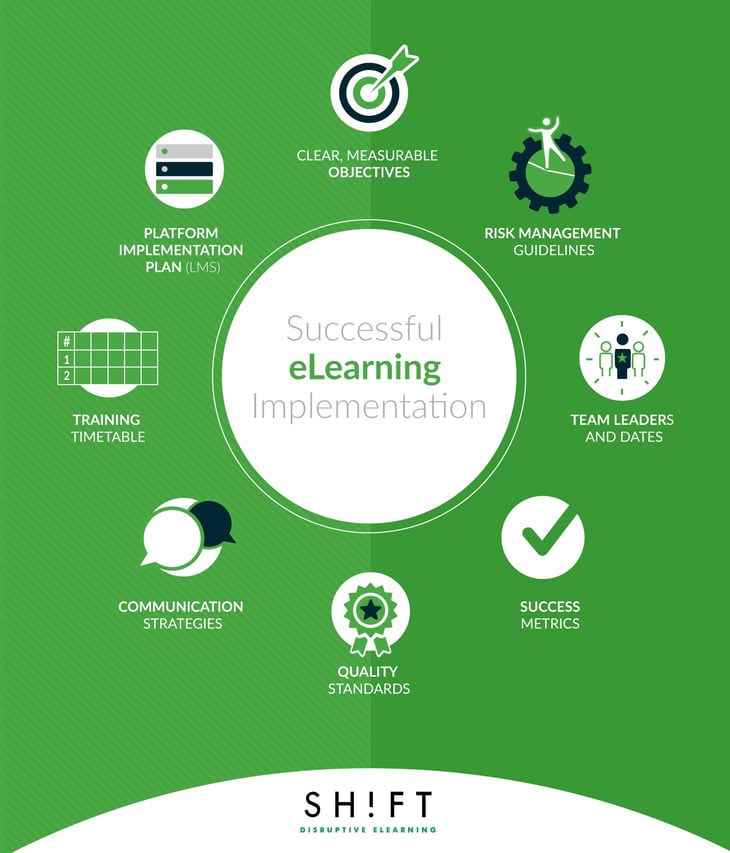Undoubtedly, one of the most important steps when adopting an e-learning solution in your organization is implementation.
Successful execution of this step is strongly related to proper planning.Proper planning in regards to tasks, project leaders, cost and other implementation elements make up the basis for adequate execution and control. This step is to project implementation what blueprints are to a construction project. Therefore, changing anything after this step may have costly consequences.
In this post we will review the seven main factors that determine the success of an eLearning project implementation plan.
"Make sure all related departments are involved, alternatives are assessed, decisions are documented ,and a plan is designed in order to abide by those decisions. This step is generally the most time-consuming and where the utmost care is required". – Juan Carlos Vidal, Operations Manager at SHIFT
Key Factors for Successful eLearning Implementation:

1) Clear, Measurable Objectives
You must collect and align all the objectives from the related departments with the project’s objectives. Aligning these objectives and expectations is usually a highly strategic process, as each department would likely have its own specific objectives. For example, finance may be hoping to reach very specific objectives in terms of investment, return on investment, savings in training programs, etc. The functional areas or departments may have expectations about time investment and training schedules; reports from users trained on highly specific data or formats who may require a tailored report system; access from several devices or areas with access and bandwidth restrictions; shared equipment; users with special schedules; team separation into areas, roles, etc. Similarly, the human resources department may have objectives concerning program design, promotion or career plans, certifications, etc. The IT department may have objectives concerning the use of department resources, use of equipment, safety requirements, budget, licensing, hardware architecture, bandwidth consumption, etc.
2) LMS Implementation Plan
Your plan should at least consider:
- Server and data base architecture;
- Applications to be installed;
- Safety and backup plan;
- Disaster-recovery plan;
- Server maintenance plan;
- Server resource monitoring;
- Software type and versions to be installed;
- Server bandwidth and bandwidth among nodes;
- Support plan for final users;
- Infrastructure scaling plan, etc.
3) Team Leaders and Dates
Getting the support and commitment from the right people plays a key role in successful eLearning implementation. The team does not have to be large; the important thing is to have people who will be directly responsible for the implementation and decision-making. Plan for a team that at least is made up of:
- A project leader, project manager or sponsor: he/she is responsible for ensuring the plan is implemented within the established time frame, with the agreed-upon resources and scope.
- Management representatives and employees from all groups who will benefit from the project (usually HR, Finance and the functional or operational areas). It is often useful to have this group test the courses before launching the, in order to determine implementation scope and objectives. This way, the company can receive feedback from the group, and appropriate adjustments can be made to the courses.
- Technical team: Working with the IT team with the purpose of determining what resources will be required to implement e-learning is critical. The IT team will help ensure preparation of hardware and software, integration with other systems, LMS safety, and scalability, as well as bandwidth issues.
Read more: How to Create an eLearning Course in 12 Steps
4) Quality Standards
Methods and procedures aimed at ensuring expectations and objectives are met must be described. Teams must perform in compliance with established performance metrics detailed in the requirements sheet, and measurable indicators must be followed up regularly in order to evaluate and promote accountability. Furthermore, each person should have a defined role, as well as defined tasks and quality requirements for deliverables.
5) Risk Management Guidelines
With technology projects, nothing ever turns out as expected or planned; especially on the first time, this type of project is implemented. Accordingly, having a risk monitoring, control and management plan is vital in the face of potential risks at any point of the eLearning implementation phase.
6) Training Timetable
This must be arranged according to training needs, which should be determined during this planning stage. Feeling pressure to train employees is natural. To deal with this pressure, it is necessary to prioritize and be able to explain the implementation plan to the related parties.
Use a table like this one to organize and prioritize course development:
|
No. |
Name of course |
Start Date |
End Date |
Target audience |
Level of Prioritization |
|
1 |
Training on product X |
12/1/16 |
12/5/16 |
Marketing and Sales Department |
1 |
|
2 |
Training on product Y |
15/2/16 |
15/3/16 |
Marketing and Sales Department |
5 |
7) Communication and Promotion Strategy
If you build the courses, students won't necessarily come. Therefore, during the implementation planning phase, you need to think how are you going to create awareness and understanding of eLearning in your company. As Jay Cross says in his book Implementing eLearning “An effective plan maps the messages, the activities and the audiences.”
Use a simple template like this one to organize your strategy:
|
Target Audience |
Message |
Strategies/Activities |
|
Mid-level Managers |
Learn time-management techniques to increase team productivity. |
1 blog post every week Create a shared practice community, where people can connect and share what they know. |
|
Sales staff |
Taking this course will help you boost your customer service skills. |
Use social media channels, forums and discussion boards to encourage excitement for the topic. Create a game to reward participants every time they complete a course. |
Read more: Here's How To Promote Your New eLearning Program Internally
Finally, ensure that there is a way to measure success
Probably one of the most critical factors for successful eLearning implementation is evaluation. It is impossible to know if your team is achieving the desired outcomes without having a structured way to measure its success. In the Implementation phase, make sure you inform your team what success looks like.
Read this article: 6 Ways to Measure the Success of Any Project
Sources:


